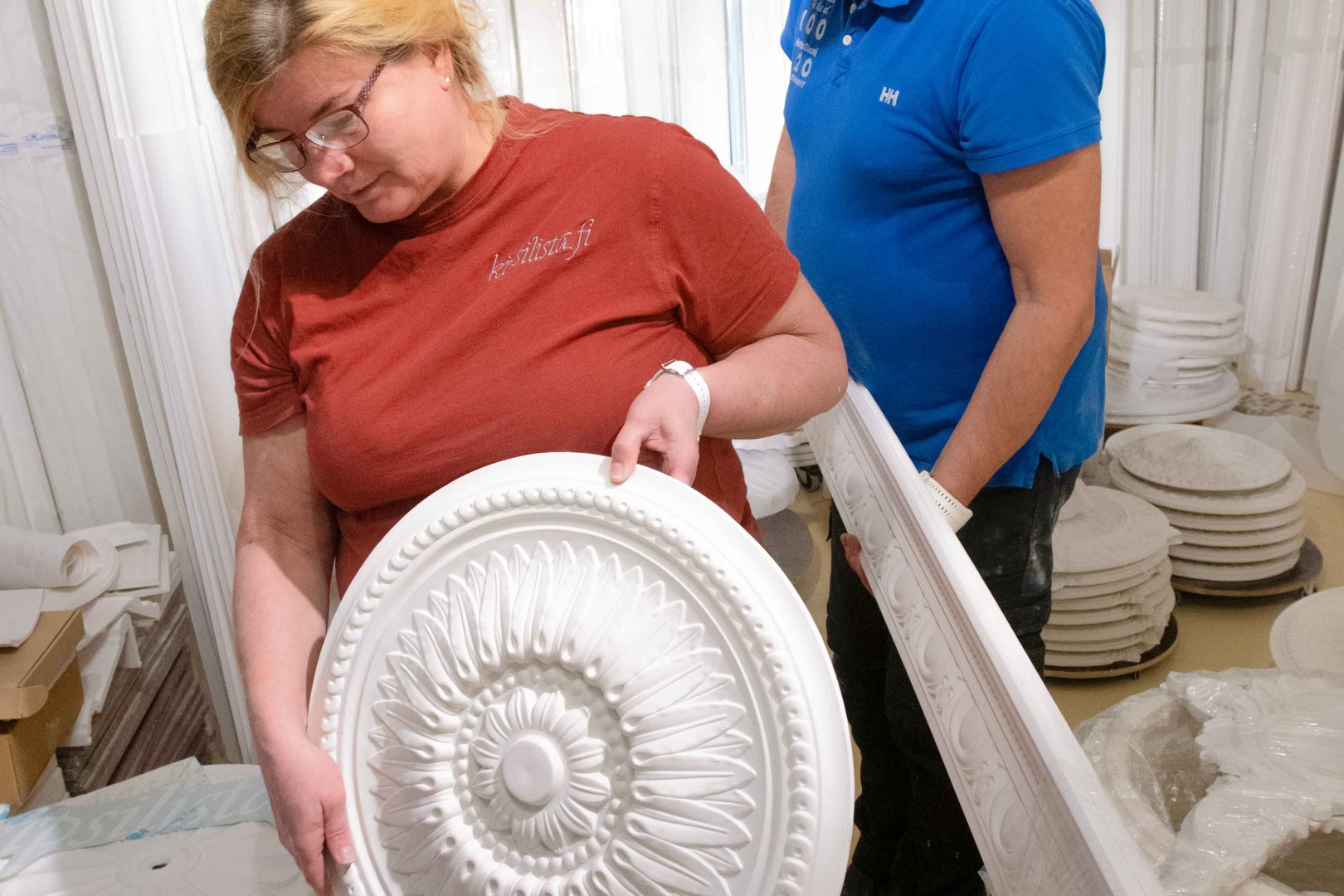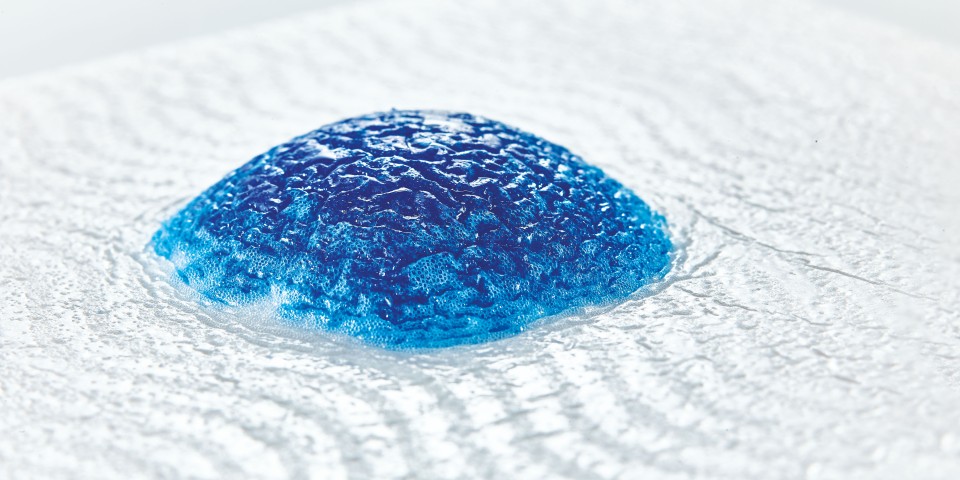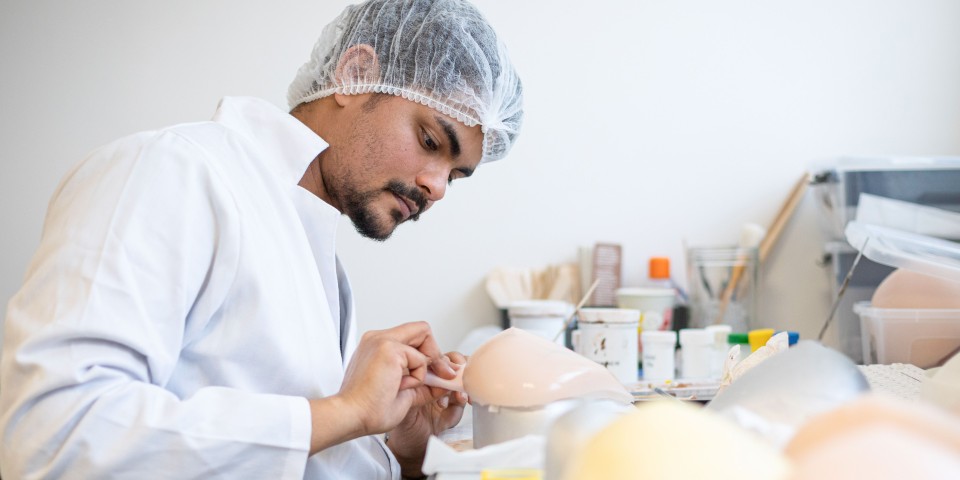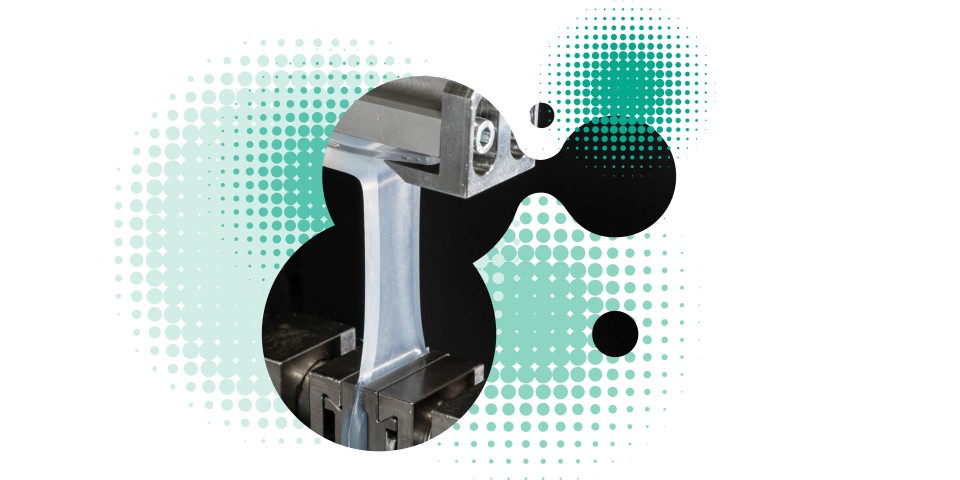
Masters of crown molding
Mar 15, 2023 Read time: approx. MinutesMinute
CROWN MOLDING
Whether shaping ceiling-light rosettes or repairing intricate designs, Finland’s master of crown molding, Kipsilista, has the answers. Their approach involves three key ingredients: high-quality gypsum; fresh, cold water; and pourable silicone rubber from WACKER, which allows the fresh gypsum to be spread and shaped with absolute precision.

While this ‘recipe’ may sound quite straight-forward, there is a whole lot more to the process of shaping raw gypsum into pieces of architectural art – and major landmarks across Finland depend on the outcome. Kipsilista crown molding adorns the walls and ceilings of Helsinki’s grand, historic Hotel Kämp, which was designed back in 1887; Kipsilista moldings also adorn the Belle Époque Grand Residence 21 apartments in Helsinki, originally designed and built by Swedish master painter and industrialist Per Erik Färlander from 1888-89. Modern and contemporary landmarks also rely on Kipsilista molding, including the Toyota Racing Head office, in Puuppola, and even the biggest mall in the nation, the Veljekset Keskinen Mall.
The company’s molding is intricately designed. Of course, detail is important, especially in these historical projects,” explains Dr. Thomas Gröer, Head of Technical Marketing, Industrial Solutions at WACKER SILICONES. “New molding has to match the original design perfectly, so the right silicone must be used, depending on the required processing time,” Dr. Gröer continues. “And the blended material results in a premium-quality molding: fireproof, moisture-free and designed to last many lifetimes, while retaining its detail and shape.” Building on these outstanding results, Kipsilista has expanded its offerings: most recently, the company has incorporated traditional crown-molding design with LED lighting.
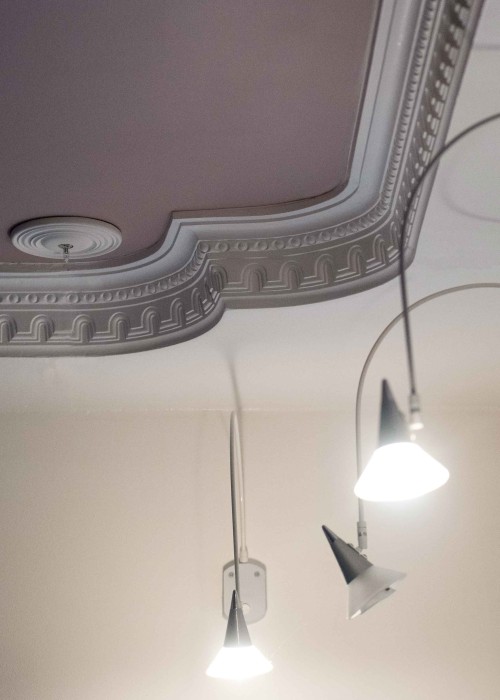
Plaster structures on ceilings are a typical and much sought-after feature of old buildings from the Wilhelminian era and can be replicated with silicone moldmaking compounds.
Kipsilista’s owners, Petri Hakala and Marjut Nättinen, started the company after they built a house in Korpilahti, Finland, on the shores of the stunning Lake Päijänne. The couple wanted plaster moldings for their property, but they could only find them in antique shops, at an eye-watering price, according to Hakala. “At that time, plaster moldings were only installed in buildings in Finland if the National Board of
Antiquities ordered it,” he explains. Before moving into their house, the couple had established a plastering company in 2002. Soon enough, the ground floor of Halaka and Nättinen’s new lake-side home became the beginning of their crown molding business, and it remains a warehouse for Kipsilista’s most sought-after plaster moldings.
The Work of Making Art
Whether it’s a simple doorstop or a decorative ceiling pattern, plaster molding pieces are made by hand. The gypsum moldings are manufactured in Korpilahti. Putting a floral pattern on the moldings with a ten-centimeter spatula requires master craftsmanship. According to Hakala, it takes almost an hour to finish installing one ornament. After 18 years of development, Kipsilista now produces an average of 27 meters of finished molding every day.
Crown-molding design, creation and installation is a labor-intensive art. Producing a gypsum crown molding starts when an architect has drawn the desired shape and size on paper or electronically. The craftsman will then use a miniature drill to make what is known as a ‘drag plate’: a wood or steel-based shape that will ‘carve’ the molding when it is still in its liquid and soft forms. The traction plate is attached to a carriage, a hand-drawn device on which the desired molding profile is aligned. Round rosettes, for example, are made by hand by rotating them around their axes. This process creates the original shape from which the silicone rubber mold is made.
“The traction phase requires the utmost precision. The reel must run smoothly, which is difficult if the molding is decorative. It doesn’t want to be pulled,” Hakala explains.
“Detail is important, especially in these historical projects.“
Dr. Thomas Gröer, Head of Technical Marketing, WACKER SILICONES
The Science of Silicone
When the moldings are made, the first one is framed on the table with plywood for extra edges. The mold is then filled with two-component silicone. Kipsilista moldings are made with WACKER ELASTOSIL® VARIO 15 and VARIO 40, silicones recommended by supplier Lindberg & Lund, a member of the Biesterfeld Group.
“Because of their low viscosity, these silicones impart special qualities to the gypsum molding material, including no shrinkage and ease of processing,” explains WACKER’s Dr. Thomas Gröer, an expert in the use of silicone for a range of industrial applications. “And the curing time can be varied, depending on the shape of the molding and whether the process needs to be accelerated,” he continues. “With deep undercuts, for example, a softer silicone with good elongation properties is needed. The material is then ideal for more intricate details and has better resistance."
The gypsum is then delivered to Kipsilista in batches of 1,200 kilograms from Germany. The pure gypsum used by Kipsilista does not contain coal or other sandy substances often used in mass-produced plasterboards because of their low cost. Instead, Kipsilista uses artist’s plaster: It is completely recyclable, emission-free, non-flammable and non-shrinkable all factors that make for a superior-quality end product.
Production requires a series of steps:
Production requires a series of careful steps. “The plaster is brought into our facility in sacks on a trolley and is moved close to the casting table. The plaster is then sprinkled into the water for mixing. The mixture is ready when the plaster powder forms islands on the surface of cold, clean water,” Hakala explains. The gypsum mass is mixed with a drill paddle. Next, the plaster is initially brushed across the surface of the mold by hand. This intensive and meticulous process prevents air bubbles from forming on the surface of the finished object. Next, a gypsum compound is added to the mold so that pre-cut fiberglass fabric (300 g/m2) can be pressed over and through it. This is an important step to ensure that the material can withstand future processing steps.
After Kipsilista’s plaster formulation has hardened for 21 minutes, the newly shaped material is carefully removed from the original mold and finally hung on a ceiling hook to dry. “The gypsum product contains far more water in relative terms than the corresponding concrete product. A gypsum product lifted from the mold weighs almost twice as much as it does when dry,” Hakala notes.

ELASTOSIL® VARIO 15
ELASTOSIL® VARIO 15
is a pourable, addition-curing two-component silicone rubber that vulcanizes at room temperature. Due to its resistance to all common reproduction materials. e.g., casting resins, concrete, plaster, as well as the mechanical properties, ELASTOSIL® VARIO 15 is especially suitable for all molds. As a low-Shore-A addition-curing silicone rubber that cures without undergoing dimensional shrinkage, ELASTOSIL® VARIO 15 is also suitable if absolutely accurate copies of models are required. It can be blended with ELASTOSIL® VARIO 40 to achieve any target hardness between 15 and 40 Shore A.
Properties
- Two base components, two catalysts
- Easy to process because of low viscosity
- Fast and non-shrink cure at room temperature, adjustable over a wide range
- Low hardness 15 Shore A
- High elongation, outstanding tensile strength
- Excellent tear strength
- Cured rubber is translucent and colorless
- Can be pigmented with 1 – 4% ELASTOSIL® Pigment Paste FL
Special characteristics of ELASTOSIL® VARIO 15
- Addition-curing
- BFR compliant
- Fast-curing
- FDA-compliant
- Low viscosity
- Non-shrinkable
- Two-component
A 2.5-meter-long gypsum slab is ready for drying in about 20 minutes. The molding needs to dry for a day or two before it is packed, sanded and packaged. Once the moldings are finished, two condensation dryers are used overnight to remove the moisture from the stack.
Kipsilista’s plaster cast team do most of their work with their bare hands, which seem to be very resistant to gypsum with its pH of seven. The team uses a bucket of water to wash their hands, as the plaster would cause blockages in the plumbing. The plaster residue from these buckets is transported to special recycling bins in the center of Jyväskylä. All the joists and extensions of the moldings are created at the installation sites.
Hakala is proud of the projects the Kipsilista team has completed, bringing and maintaining elegance to buildings across Finland. WACKER’s Dr. Gröer is equally proud of the science behind them: “WACKER ranks among the leading global producers of the silicone rubber needed for such intricate projects, whether for architecture, design, or even fields like television and theater, where unique and durable shapes are needed.”

When the ceiling rosettes are released from the silicone mold, they replicate the historical original in every detail.
Contact
For more information on this topic, please contact:
Mr. Dr. Thomas Gröer
Leiter Technisches Marketing
Industrial Solutions, WACKER SILICONES
+49 8677 83-6940
Send message





